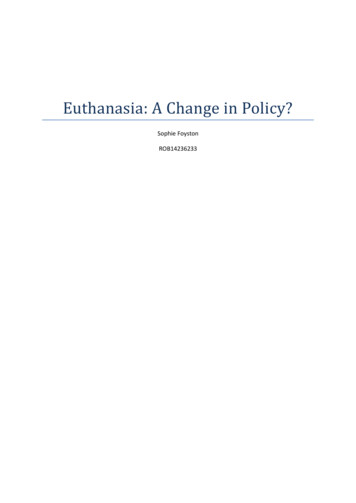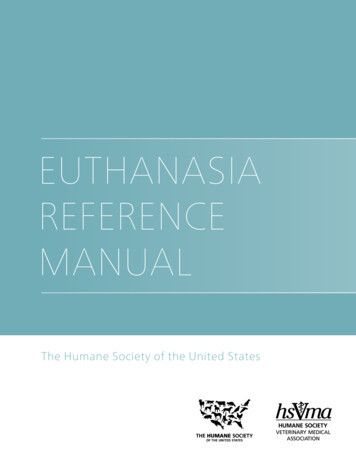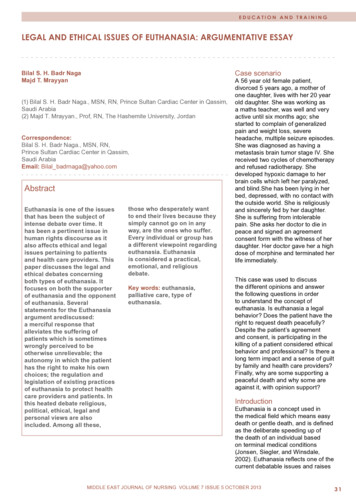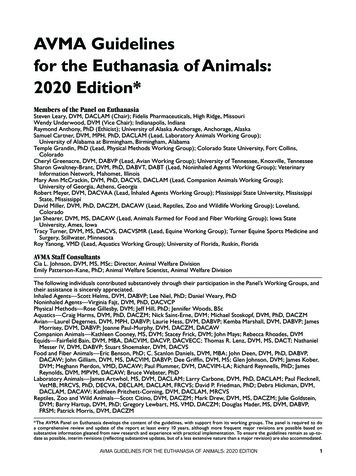
Transcription
Euthanasia: A Change in Policy?Sophie FoystonROB14236233
Sophie FoystonUnit 1Table of ContentsIntroduction . 5Glossary . 6Current Legal Stance . 7Euthanasia. 7Assisted Suicide . 7Voluntary Suicide . 7The Possible Causes of the Crime . 7Biological . 7Genetic . 8Physiological. 8Cause of Crime . 8Cause of Criminality . 8Positives and Negatives . 9Left and Right Realism . 9Left Realism . 9Right Realism. 9Individualistic . 10Psychodynamic . 10Behavioural . 10Cognitive . 10Causes of Crime. 10Causes of Criminality. 10Positives and Negatives . 10What Policies Would be Used? . 11Biological . 11Individualistic . 11Sociological . 11Strain Theory . 11Social Reaction Theory . 11Culture Conflict Theory . 12Social Disorganization Theory . 12Realism Theory. 12Causes of Crime. 122
Sophie FoystonUnit 1Causes of Criminality. 12Positives and Negatives . 12How Theories Help to Make Policies . 13Broken Window Theory . 13Theories over Time . 13Nature Theory . 13Nurture Theory . 13Psychodynamic Theory . 13Social Disorganisation Theory . 13Strain Theory . 14Interactionism Theory . 14Culture Conflict Theory . 14Social Reaction Theory (Labelling) . 14Behavioural/ Social Learning Theory . 14Cognitive Theory . 14Realism Theory. 14Policy Implications and Strategies for Tackling the Problem . 15Social Changes. 15Social Values, Norms and Morals . 15The Death Penalty . 15Homosexuality . 15Euthanasia . 15Law Making Process . 16Consultation Stage . 16First Reading. 17Second Reading . 17Committee Stage . 17Report Stage. 17Third Reading . 17Royal Assent . 17Judicial . 17Alterations. 18Different Houses . 18Who is currently affected by the situation? How are they affected? . 183
Sophie FoystonUnit 1Possible Causes of Criminality. 18New Policy Proposal. 18Impacts from New Policy . 18Impacts. 19Victims. 19Perpetrators . 19Society . 19Conclusion . 19Reference Page . 204
Sophie FoystonUnit 1IntroductionIn this report we will be discussing the arguments for and against euthanasia, with reference torecent case studies. We will also be reviewing if a change in policy would be appropriate at this timeand we will be producing a proposed change to the current euthanasia policies. We will be reviewingthis as a recent case study has brought about many questions as to whether assisting in a person’sdeath should be illegal. The main arguments for euthanasia are that people have a lack of quality oflife and that they deserve dignity in their death. The main arguments against euthanasia include thefact it can devalue a person’s life and all of the religious views.5
Sophie FoystonUnit 1GlossaryIn this report I will discuss the following terms: EuthanasiaThe term euthanasia means to intentionally terminate a person’s life, sometimes not alwaysat that person’s request.Assisted SuicideThe term assisted suicide means to help a person commit suicide, if they are unable to finishit themselves.Voluntary SuicideVoluntary suicide means to take your own life without the help of anyone else.PsychologicalPsychological refers to a person’s mind and/or emotions.GeneticGenetics refers to a person’s genes and/or DNA.Left/ Right RealismThe terms left and right realism relates to two different extreme political views; both onopposite sides of the spectrum.BiologicalIn terms of criminology, the biological theory’s refers to criminal behaviour that could becaused due to a fault in the brain.SociologicalIn terms of criminology, the sociological theory’s refers to criminal behaviour that could becaused do to a person’s geographical location.IndividualisticIn terms of criminology, the individualistic theories refer to criminal behaviour that could becaused due to a fault in emotions or a way a person thinks.ValuesValues are standards or principles of behaviour. These values can affect a person’s outlookon life.NormsNorms are informal standards set by society.MoralsMorals are a person’s own principles of what is right and what is wrong.PrecedentsPrecedents are a legal decision that must be followed in similar cases. Precedents are set byjudges.JudiciaryJudiciary is another term for all judges collectively.6
Sophie FoystonUnit 1Current Legal StanceEuthanasiaPsychology.org states that “the term “euthanasia” refers to the intentional termination of a person’slife” (Psychology.org, 2017). Currently in the United Kingdom it is illegal to assist in an act ofeuthanasia. Although there are no current laws against euthanasia, if a person has participated theywill be charged with manslaughter or murder and could face up to life in prison. (Kamouni, 2016)A major case that affected the laws on euthanasia was the case of Kay Gilderdale. Her daughtersuffered with many long term illnesses and from the age of 15 years old was paralysed. In her 30s,Kay’s daughter made the decision that she would end her life but she needed her mother’s help. Thenight in which the daughter died, Kay herself had to finish the process of injecting her daughter withmorphine. She was later charged with murder although she pleaded guilty on assisted suicide.(Hirsch, 2010)As the case progress it brought into question if the laws on euthanasia should be changed.Assisted SuicideUnder the Suicide Act of 1961 assisting a person to commit suicide is a criminal act and is punishablewith up to 14 years in prison. (InBreif, 2017)In 2010 a mother was charged with attempted murder after injecting her son with a lethal dose ofheroin. Her son was resuscitated at that time however a year later she tried again and this timesucceeded. Her son, who had suffered major head injuries, was in a deep coma and was believed tonever wake up. The mother, who was convinced he would never recover, was originally sentencedto a life sentence with a minimum of 9 years, under Schedule 21 of the Criminal Justice Act 2003;however this sentence got reduced to a minimum of 5 year. (Lloyd, 2010)This case was the first involving a mercy killing and it became the centre of a large debate: Shouldthe current laws be changed? Many points were made as to why the mother should not have beencharged with attempted murder as she was not going to commit a murder again. After muchdiscussion no changed were made and a mandatory life sentence is still in place.Voluntary SuicideAt the moment in the UK it is legal to voluntarily take you own life. (NHS, 2014) This was after achange in law in the 1980s. Before then it was illegal to commit suicide and a person could bepunished with a prison sentence if the suicide attempt was not successful. These changes weremade to the Suicide Act of 1961.The Possible Causes of the CrimeBiologicalThe biological theory states that a person is more likely to commit a crime if they have any mentalabnormalities (Cowrey, 2016).7
Sophie FoystonUnit 1GeneticThe genetic theory states that criminality is based on a person’s DNA. The genetic theory worksalongside the nature side of the nature and nurture theory. The nature theory overall states aperson is born evil and it is in their blood to commit crimes. This DNA could be passed down from aparents DNA. An example of this would be if a parent is a known shoplifter, the genetic theory statesthat their child will also be a shoplifter.PhysiologicalThe physiological theory can be broken down into three basic theories: Psychodynamic, behaviouraland cognitive.PsychodynamicThe psychodynamic theory was developed by Sigmund Freud. He proposed the idea that crime isdue to mental issues that a person may suffer with. He also suggested that a person’s actions arecontrolled by their subconscious mind.BehaviouralThe behavioural theory, also known as the social learning theory, was developed by Albert Banduraand believes that a person’s behaviour is directly affected by the absence of the motor reproduction.CognitiveThe cognitive theory was developed by Jean Piaget in 1936. He believed that cognitive developmentis a process within the mind that results from the maturing of a person’s biological aspects in theirbrain.Cause of CrimeIt states that Mr P suffered severe head trauma some years before his wife’s death. His family statesthat after this injury he showed more impulsive behaviour and his personality changed. This is alsoshown in the case of Fred West. At the age of 19 Fred West was in a motorbike accident that left himin a coma and caused damage to his brains. After the accident his family and friends claimed his fullpersonality had changed. He would have violent outbursts, and was more aggressive.It is believed that if a person suffered with a damaged frontal lobe, this could have majorcontributing factors towards criminal behaviour. This is due to the fact that the frontal lobe controlsa person’s emotions. By damaging it, a person can lose control over their emotions; the mostcommon symptom of a damaged frontal lobe is aggressive outbursts (Clooney, 2005).We can see much similarity between the case of Mr P and Fred West. This supports the biologicaltheory as it supports the belief that if a person commits crime it is due to a fault in their genetics; ofwhich both Mr P and Fred West showed signs off.Cause of CriminalityThis theory suggests the causes of criminality are that a person is born evil and that it is in theirgenetic makeup. This theory shows that a person with a superego may be more likely to commitcrimes.8
Sophie FoystonUnit 1Positives and NegativesThis theory can be scientifically proven by looking into a person’s brain; however can also be quitehard to prove. One point put across is that a person with a damaged frontal lobe of the brain is morelikely to commit crimes, however not everyone who have suffered head injuries have becomecriminals.This theory also states that you can predetermine who will be a criminal by looking into their DNA.Although resent medical advancements makes this possible, it would be hard to examine everyperson in the world to determine if they will become a criminal. Also, like stated before, noteveryone with brain damage become criminals.By saying a person is born evil, it could bring about stereotypes. By suggesting ‘evil’ DNA can bepassed down from parents, this could place a divide between family member of criminals and thegeneral public.By being able to determine what parts of the brain controls our actions and emotions, this theoryhas helped in the development of effective treatments for mental illnesses. On the other hand, thistheory its self is to over simplistic; there is too much emphasis on biology when it has been proventhat humans have just a bigger impact on each other’s actions and behaviour.Left and Right RealismLeft RealismLeft realism has a better understanding of people and why they do the things they do. In regards topunishments for criminals, they are more likely to focus on the rehabilitation of a person, other thana long prison sentence.This may effect a change in policies as left realists are more likely to see punishments as too harshand will be willing to make sentences more focused on helping a person instead of punishing them.In regards to the case in question, a left realist government would be more likely to legalizeeuthanasia within the UK and would set up more help services for those going through it. This isbecause they would try and emphasis with a person and try understand their situation instead ofjudging them.Right RealismRight realism is harsher towards criminals and makes a point that every criminal is bad and deservesthe worst punishment possible for a crime. Right realists state that crime is a personal choice madeby the criminal and they must face the consequences, regardless to the situation.The may effect a change in policies as right realists are more likely to increase prison sentences andmake more things illegal. Right realists are also more likely to remove any support set up to helpcriminals.In regards to the case, a right realist government is more likely to charge anyone involved witheuthanasia with murder and give them a life sentence in prison. They are also more likely to make itharder for people who want euthanasia to receive the help needed. This is due to the fact theywould see it straight as murder and are less likely to try and understand the situation a person is in.9
Sophie FoystonUnit 1IndividualisticThe individualistic theory states a person is more likely to commit a crime if they suffer frompersonality faults.PsychodynamicThe psychodynamic theory was created by Sigmund Freud and states that a person who commitscrime does so due to personality traits picked up in childhood from a lack of love. Freud states that aperson is likely to commit crime if they have had a poor childhood.BehaviouralThe behavioural theory was created by Albert Bandura and states that a person is likely to commitcrime dependant on their learning experiences. Bandura believed a criminal’s behaviour is due totheir reactions and will learn through modelling behaviour portrayed from family, friends and themedia.CognitiveThe cognitive theory, developed by Lawrence Kohlberg, states a person who commits crimes does sodue to their moral development and information processing.Causes of CrimeThe individualistic theory states that a person’s actions depend on their personality and theirupbringing. When looking at the case we see that Mr P had very traditional views towards women;this caused many disagreements between the couple. We also see that Mrs P’s children stated hewas controlling towards their mother.These traits in personality may have come from behaviour he experienced at home as a child andwhilst he was growing up. There are no mentions on how his family treat him whilst he grew up sowe cannot say that he was abused as a child, although his views on life may have come from familymembers.Causes of CriminalityThe individualist theory states that mistreatment can cause criminal tendencies. It also states thatthis mistreatment can course personality faults and can affect a person’s mental process. It has alsobeen stated that a low intelligence may be a cause of criminality.Positives and NegativesThe individualistic theory focuses on individuals, meaning it can offer the specific support needed fora person. However this also means treatment for criminals, under this theory, can be very timeconsuming.The individualistic theory states that the best form of treatment/punishment for a criminal isrehabilitation. This can help criminals find different ways to deal with the trauma of their past.However this can also build stereotypes of criminals. For example it states if a person has a badupbringing they are going to commit crime in later life; however not all people from these sort ofbackgrounds turn out as bad people. On the flip side some people who have brilliant upbringingscommit crimes in their later life.10
Sophie FoystonUnit 1The individualistic theory can also be seen as giving excuses for criminals as to why they commit thecrimes they do.What Policies Would be Used?BiologicalPeople who support the biological theory say that a person commits crime due to a biological faultand their response to dealing with criminals can be seen as right wing. People who support thebiological theory would support the idea that all criminals should be locked up as there is nothingthat can be done to help them. On the other hand some may suggest medication as a way tomedically treat criminality; this is achievable as if someone has a problem with their genetics, due tomedical advancements, they may be able to treat it with medication.In the case of Mr P, the biological theory states that he may have murdered his wife due to the braindamage he suffered. They would recommend that either medical alterations be done on his brain tochange the way his genetics work, and/or that he be put in prison as he is untreatable.IndividualisticPeople who support the individualistic theory say that a person commits crime due to their thoughtprocess and any psychological problems. They are more likely to support left wing beliefs on howcriminals should be treated. As they believe criminals are psychologically wrong, people who supportthe individualistic theory are more likely to suggest that people who commit crimes need support inchanging the way they think. Some ways of achieving this are rehabilitation and counselling.In the case of Mr P, the individualistic theory states that he may have murdered his wife because ofthe way he thinks. This may be due to his upbringing or the people he was raised around. Theywould recommend that he is set to rehab to find the root cause of his criminality and then theywould offer support in ways he could deal with that.SociologicalThe sociological theory suggests a person is more likely to commit a crime if they live in a bad areaand/or they come from the lower class.Strain TheoryThe strain theory was developed in 1957 by Robert K Merton and he suggested that an individual isput under pressure by society to achieve goals set out by society. This can lead to crime as if aperson lacks to means to reach these goals they may resort to criminal methods. An example of thiswould be if society puts across that owning a certain pair of shoes is what is acceptable, however aperson cannot afford these shoes themselves, they may resort to crime to either get the money tobuy the shoes or they may just steal the shoes.Social Reaction TheorySocial reaction theory, also known as the labelling theory, suggests that the more a label is put on anindividual, the more they are likely to act upon that label. An example of this would be if in arelationship a person is constantly labelled as a cheater, they are more likely to go out and cheat ontheir partner.11
Sophie FoystonUnit 1Culture Conflict TheoryCulture conflict theory suggests that crime is caused due to a clash of values and morals that canarise when different social groups have different ideas of acceptable behaviour. This conflict couldresult in criminal behaviour.Social Disorganization TheorySocial disorganization theory suggests that an individual’s actions are based on the social order of acommunity.Realism TheoryThe realism theory is separated into two sections: left realists and right realists.Right RealismRight realists emerged in the 1970s and 1980s and have a zero stance tolerance on crime. Theybelieve crime is caused due to three defining factors: biological differences, socialisation of theunderclass and a rational choice to offend.Left RealismLeft realists believe crime is caused due to deprivation from relatives. They also believe that crimemainly affects people from a working class background.Causes of CrimeThe sociological theory suggests a person is more likely to commit crime due to their socialupbringing and social setting; however we are not reviled anything about Mr Ps area. From this wecan come to a conclusion that he may have been brought up in a bad area with a low income. Thiscould have led to him killing his wife as she was a wealthy business woman and he would gainfinancially from her death.We could also believe he is from a culture in which women have less rights then men, and/or it islooked down on when a woman earns more than a man. This may have led to Mr P murdering hiswife and he may not have agreed to her earnings and her job.Causes of CriminalityThe sociological theory suggests a person is more likely to commit crime due to their financialsituation and/or there view on the world. It also suggests, much like the individualistic theory, that aperson is influenced by their family, friends, media and/or their local area.Positives and NegativesThe sociological theory suggests a person can easily be changed through rehabilitation and a changeof circumstances, giving them an overall second chance. However this can be seen as too soft oncriminals and may also be seen as giving them an excuse for committing a crime.This theory can also give people a better understanding as to why crime occurs as it is not narrowminded; it can also pin point where a crime is more likely to occur and/or who participated in thatcrime. This is a positive as it can help to police when focusing on areas of crime. However this mayalso be seen as stereotyping and much like the labelling theory, this can encourage people tocommit more crimes, just because they are in a bad area.12
Sophie FoystonUnit 1How Theories Help to Make PoliciesTheories can help make policies as they can work on the root cause of a crime rather than the endoutcome. This means that more facilities can be put in place to help criminals, such as rehabilitationcentres and counselling services.Broken Window TheoryThe broken window theory suggests the basic idea that if a window is broken and not repaired, therest of the surrounding windows are more lik
alongside the nature side of the nature and nurture theory. The nature theory overall states a person is born evil and it is in their blood to commit crimes. This DNA could be passed down from a parents DNA. An example of this would be if a parent is a known shoplifter, the genetic theory states that their child will also be a shoplifter.



![Change Management Process For [Project Name] - West Virginia](/img/32/change-20management-20process-2003-2022-202012.jpg)






